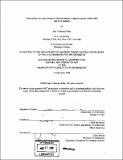Cakewalking into representation : Gabriele Münter's America travels (1898-1900) and art of dailiness
Author(s)
Bible, Ann Vollmann
DownloadFull printable version (113.5Mb)
Alternative title
Gabriele Münter's America travels (1898-1900) and art of dailiness
Other Contributors
Massachusetts Institute of Technology. Dept. of Architecture.
Advisor
Mark Jarzombek.
Terms of use
Metadata
Show full item recordAbstract
This study explores the fashioning of Gabriele Münter as a German modernist with a focus on the eclipse of her struggles in coming to representation, the rich complexity of her processes, and the importance of dailiness for her work. Drawing on feminist readings of autobiography and on the relationships elaborated by Henri Lefebvre and Georg Simmel between modernity and the everyday, the daily is described here as an expansive site encompassing subjugating repetition and familiarity as well as discourses of worldliness and possibilities for subversion. The discussion centers on Münter's travels in the United States as an emblem of the stretch of her dailiness and its instructive vantage on issues of authenticity and documentation governing her output. Miinter's pocket calendars, sketchbooks, photographs, photograph album, and retrospective writings about America are considered as a project of forging Heimat and visuality. With its associations of effortlessness, the use of "cakewalking" in the title evokes the erasure of Miinter's daily processes in their messiness. The cakewalk was a form for African Americans to parody their masters in the antebellum period and was taken up by whites at the time of Münter' s visit; she herself designed a postcard of a young relative performing the dance. Though the daily enabled Münter to come into representation, by its slightness and imbrication in mass culture, it would go underground in service of authenticity. The argument is grounded in the American context through readings of period guidebook literature, discourses of shopping and fldnerie, and Kodak advertising; theatrical productions and tourist sites Münter visited; and relationships between her work and contemporary Arkansas photographers such as Harry Miller. (cont) The 19th-century German popular literary figuration of America as adventure elaborated by Charles Sealsfield, Karl May, and others shapes the interpretation, as do Wilhelmine discourses of empire lodged in Die Gartenlaube, the Vilkerschauen, and the shifting meanings of Kultur. The conclusion develops the relevance of the lens of dailiness for Münter by turning to four of her paintings - Man in an Armchair, Interior, Return from Shopping, and Boating - with an interwoven treatment of her writings, photographs, sketchbooks, and ephemera.
Description
Thesis (Ph. D.)--Massachusetts Institute of Technology, Dept. of Architecture, 2008. Includes bibliographical references (p. 433-457).
Date issued
2008Department
Massachusetts Institute of Technology. Department of ArchitecturePublisher
Massachusetts Institute of Technology
Keywords
Architecture.